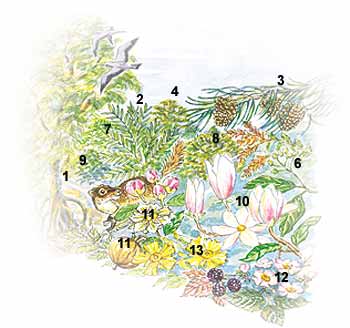Plants

Members of the Plant Kingdom grow from an embryo into a multicellular organism with cellulose in their walls. They photosynthesise (employing the sun's energy to make sugars from water and carbon dioxide) using chlorophyll (the green coloration). A vascular plant is one that contains special cells that allow water to move through it. Non-vascular plants lack these special cells.

Of the 300 000 species of plants in the world today, about 250 000 are flowering plants (angiosperms). Their diversification started in tropical regions during the Cretaceous and by the Palaeogene they had spread globally. The oldest known fossil angiosperms were found in Lower Cretaceous rocks in America and Russia. They are known from their leaves, pollen, seeds, branches, etc. Flowers are short-lived, delicate and rarely fossilised.
The Earth blooms in the Palaeogene forest (about 50 million years ago).
Conifers are the largest and longest-living plants ever to have grown. The giant redwood, Sequoiadendron giganteum, which grows in the mountains of Sierra Nevada, California, was once much more widespread than today. They grew in Derbyshire, for example, only six million years ago.